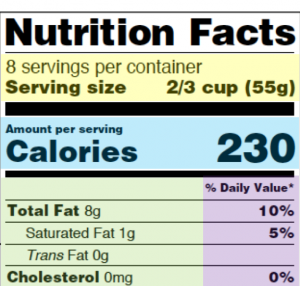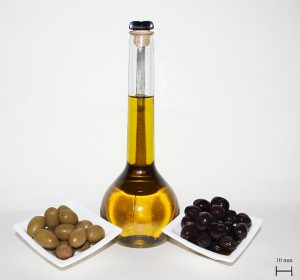Unit 5 – Lipids: Fats, Oils, and Cholesterol
5.1 Introduction to Lipids
Most people refer to this group of nutrients as “fats,” however the appropriate name is “lipids.” They are a family of organic substances that are mostly insoluble in water, meaning they do not mix well with water. Like carbohydrates, fats are considered a macronutrient because they’re measured in grams; we typically consume 70 to 100 grams each day. Because they provide 9 kcal per gram, instead of 4 kcal like carbohydrates, some people consider them “fattening.” In reality, we need to consume a certain amount of fats to survive.
Recall from Unit 2, that the first four items listed on Nutrition Facts labels are lipids: total fat, saturated fat, trans fat and cholesterol. They are listed first because they are considered “nutrients of concern” and should be limited in our diets. Countless years of studies have shown that reducing the intake of these lipids reduces risk of heart disease.

This unit introduces the three classes of lipids: triglycerides (fats and oils), sterols (cholesterol), and phospholipids. After looking at the structures, sources, and functions of lipids, we’ll discuss how the body handles them with health implications of diets high in certain types of lipids.

Unit Learning Objectives
After completing this unit, you should be able to:
- Discuss the various functions of lipids in our bodies and our diets.
- Identify the three major types of lipids, and describe their structure, food sources, and functions.
- Describe the structures, food sources, and health effects of saturated, polyunsaturated, monounsaturated, and trans fatty acids.
- Identify and define the essential fatty acids and their major functions.
- Describe the processes of digestion and absorption of fats in the body.
- Describe how lipids are transported around the body and utilized by cells, and what blood cholesterol values indicate about a person’s health.
- Explain the dietary recommendations for fats and cholesterol, and the effects they have on heart health.
Attributions:
- Lane Community College’s Nutrition: Science and Everyday Application “Introduction to LIpids” CC BY-NC 4.0
Image Credits:
In chemistry, a substance containing a carbon-hydrogen bond.
Conditions that affect the heart; the most common type is coronary artery disease (CAD), which affects the blood flow to the heart often resulting in a heart attack.

